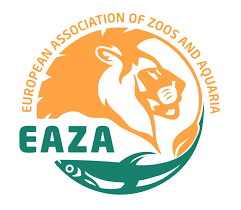
The Bearded Vulture Eglazine returned to the Netherlands! Even though wandering is normal for young individuals of this species, there are no other records of a Bearded Vulture making such a journey to northwestern Europe twice.
Hatched in captivity, released to the wild
Eglazine hatched in Parco Natura Viva back in March 2020 within the Bearded Vulture Captive Breeding Network, coordinated by the Vulture Conservation Foundation (VCF) on behalf of EAZA’s EEP. Around three months after hatching, the LIFE GypConnect project (2015-2022) received the female vulture and an LPO team at the Grands Causses’ technical site fitted her with identification rings and a GPS transmitter for monitoring purposes. They proceeded to release Eglazine in the Grands Causses using the hacking method, placing her into an artificial nest located at a suitable habitat. This method replicates the species’ natural way of fledging, allowing young and captive-bred Bearded Vultures to safely interact with each other and surrounding wildlife while spending a few weeks acclimatizing to their new environment in preparation for their first flight into the wild. Her release strengthened the project’s ultimate and long-term objective to establish a Bearded Vulture breeding population in the Massif Central and the Pre-Alps.
Eglazine’s first excursion to the north
After exploring the Grands Causses for about nine months, the young vulture began her wandering adventure on 19 April 2021. She flew over downtown Paris, eventually reached the English Channel and continued along the North Sea coast. She entered Belgium on 30 April and crossed the country in a single day to land in the Netherlands. Since then, she widely toured the country and also crossed over to Germany in Mid-May. By June, she made her way back to the Netherlands, arriving in the National Park Hoge Veluwe. She remained there until 8 October, when she started making her way south, reaching Belgium the same day and covering a distance of 150 km in three hours. On 10 October, she finally arrived in France.
Bearded Vulture Eglazine makes her way back to the Netherlands

Eglazine spent the winter back ‘home’ in the Grands Causses until she embarked on a new and surprising journey. On 27 April, the vulture left for the north once again, roughly following the same route as her return journey in autumn 2021. Eglazine travelled through Clermong-Ferrand, the Morvan, Auxerre, Troyes, and crossed the Belgian border on 2 May, near Charleroi. From there, she went northwest close to Bruges but made a sharp turn to the east to spend the night near Mechelen.
On 3 May, she crossed the Dutch border near Hoge Mierde and roosted on the Oirschotse heath. The next day, she came in a straight line in the direction of the Lemelerberg (where she spent also several weeks in 2021), but took a sharp turn to go to the Veluwe. There she spent the night in a familiar place, where she had slept many times before over the last year. It has been over a month, and Eglazine is still in Veluwe and is doing well. She often undertakes small trips within the area and doesn’t sleep in the same place every day. Just like last year, the VCF’s president Hans Pohlmann, a Dutch resident, closely monitors her progress in the field and through her GPS transmitter to ensure she is safe and healthy.
First Bearded Vulture to revisit northwestern Europe twice
It is normal for young Bearded Vultures to travel vast distances and explore new areas. A study in the Pyrenees even estimates that young individuals have a range of up to 10,000 km². Over the years, several immature Bearded Vultures, both released and wild-hatched birds, move away from the mountains, usually in spring during their second calendar year. Typically, after some days or weeks, they return to their mountainous habitats, but sometimes they need to be rescued, like in the case of Bearded Vulture Schils. Until today we don’t know why some young birds undertake these huge travels while some do not. It might be that they follow other migrating birds and are aided by strong winds, but we do not know precisely why.
The case of Eglazine is quite special. She has spent six months away from her release site during her first excursion to the north – we never observed such a long period away from ‘home’ for one of our GPS-tagged birds. Her recent return to the Netherlands marks another unique behaviour for the Bearded Vulture since it’s the first time an individual of this species carried out such a northern excursion twice.
Her exact whereabouts will remain private to avoid disturbance as she needs to rest, eat and recover after this long journey. We urge the public to keep their distance if they encounter Eglazine to help guarantee her wellbeing.
The LIFE GypConnect project

Led by the League pour la Protection des Oiseaux (LPO), the LIFE GypConnect project aims to establish a breeding population of Bearded Vultures in the Massif Central and Department of the Drôme. Releasing captive-bred Bearded Vultures into the wild at sites such as the Parc Naturel Régional des Grands Causses, Parc Naturel Régional des Baronnies Provençales and Parc Naturel Régional du Vercors will create a core population that will connect the two populations of the species in the Alps and Pyrenees. To facilitate movements between the new population and the Alpine and Pyrenean populations the LIFE GYPCONNECT team is creating a network of supplementary feeding stations, and tackling threats such as poisoning, collision and electrocution with the electricity infrastructure.







